By Michael Mozdy
The race for nuclear weapons in the 1940s gave us great knowledge and great disaster. High in the remote Ural Mountains of south-central Russia, the Soviet Union built a secret nuclear factory called Mayak to produce weapons-grade plutonium. The nearby city Stalin constructed was so secret that it didn’t appear on maps and wasn’t even given a name. They called it by its codename, City 40. If you were sent there as a worker or scientist, you never left.
Unfortunately, their highly radioactive nuclear waste was disposed of carelessly. Stored in leaky containment tanks or simply dumped into lakes and rivers, it led to significant disasters. The CIA became aware that something was wrong when they detected higher-than-normal radiation levels in the Arctic Ocean, several thousand miles away. Tracing it upstream, they found the source at the head of the Techa River: the Mayak nuclear facility.
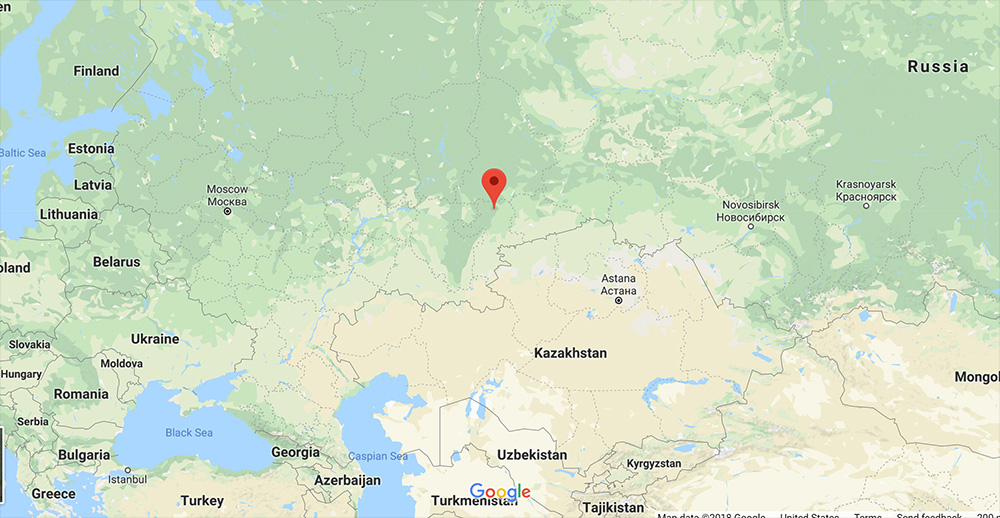 |
| World map showing location of the Mayak nuclear facility in south-central Russia. Image: Google. |
In 1957, a storage tank in the Mayak complex exploded, sending 70 tons of radioactive waste a mile high; a cloud of radiation contaminated 20,000 square miles of land. This became known as the Kyshtym Disaster – the world’s third worst nuclear disaster after Chernobyl and Fukushima – but for decades the Soviets denied that anything had happened. Things got worse: their new strategy of dumping waste directly into Lake Karachay (also within the Mayak complex) backfired when a drought in 1967 exposed sediment to winds and toxic dust spread over 900 square miles to towns and cities.
Denials and coverups continued for decades – City 40 wasn’t even given its name “Ozersk” until 1992 – and that makes it all the more incredible that a Radiobiology professor from the University of Utah became one of only a handful of people to regularly visit the area. His name is Scott Miller, PhD, and his journey from a campus lab to the most contaminated place on earth is a fascinating one.
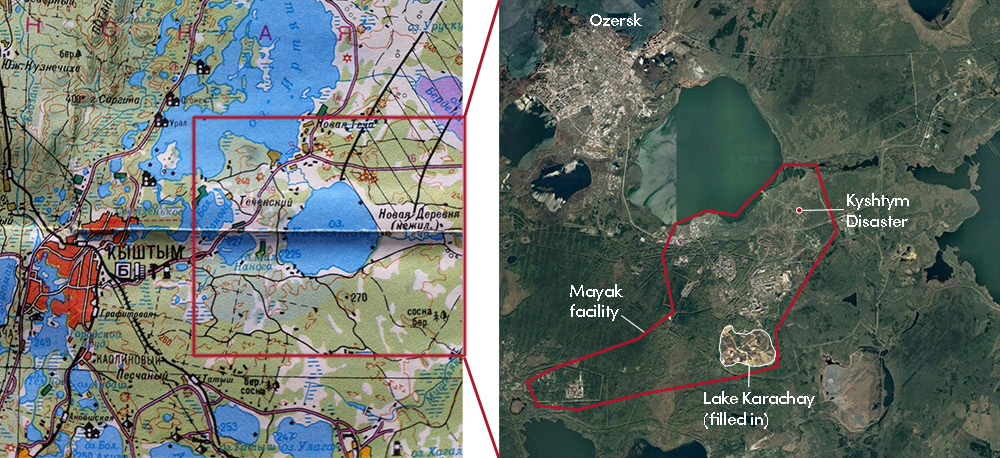 |
| Left: detail from a Russian map showing nothing where the city of Ozersk and the Mayak facility are located. Right: Google Earth satellite images of the area showing development. Locations for incidents mentioned in article are noted on this map. |
A Child of the Manhattan Project
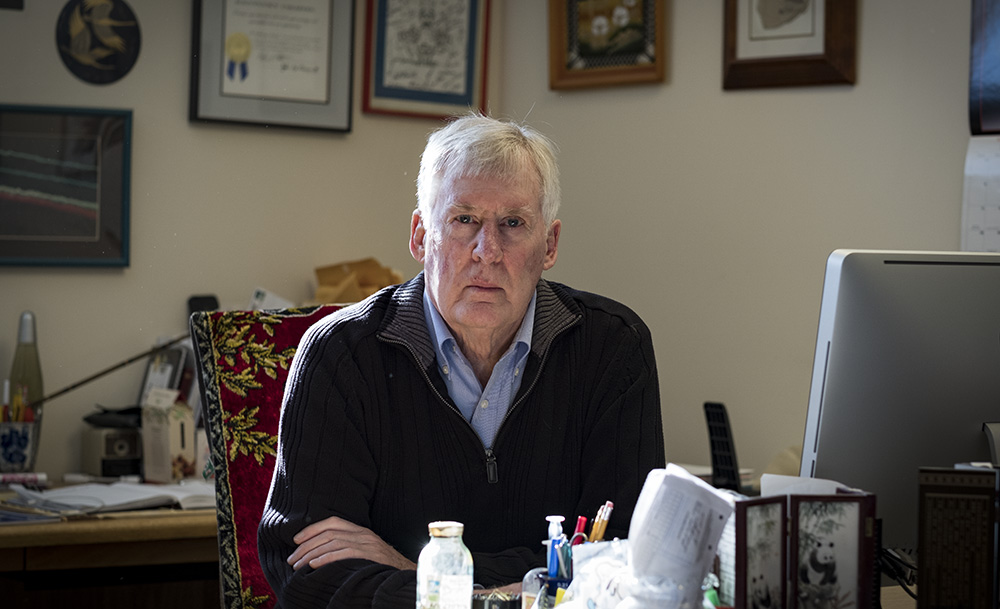 |
| Scott Miller, PhD, Section Chief of Radiobiology, at his desk. Photo: Ashlee Pinegar. |
Scott C. Miller was born the second of four boys in Holladay, Utah, five years after the nuclear bombs were dropped on Hiroshima and Nagasaki. He and his brothers grew up during the height of the cold war, kneeling under desks at school during nuclear drills and daydreaming about G-Men. His natural curiosity and love of the sciences led him to a biology degree, and after a stint in the Air National Guard as a flight medic, to pursue a PhD in Anatomy at the University of Utah.
Miller stumbled into the tutelage of a group of scientists working for the U.S. government. The Radiobiology Department at the University of Utah had been continuously funded by the Atomic Energy Commission – now the Department of Energy – since 1950 (and continues to be funded by them to this day). A generation of scientists at the U had been charged with the task of figuring out how this newly unleashed nuclear radiation affected biological tissues.
“The mission,” Miller explains, “was to look at the toxicity of the stuff at the bottom of the periodic table that’s involved with production of the nuclear fuel cycle.” These scientists were Miller’s mentors, spun out of the Manhattan Project, working to better understand the effects of radiation at a time when U.S. and Soviet weapons production was skyrocketing.
At the time, the Radiobiology program was the largest single research program at the University, with 60-80 employees. “I was a hungry graduate student eating ramen in my dorm,” laughs Miller, “and they had the resources to pay me so I could afford my housing.” Little did Miller know that working with his advisor, Webster Jee, PhD and others would establish him as a scientist with a highly sought-after knowledge base.
Miller’s first published work examined how a soap additive affected bone. Miller and Jee found that a group of chemicals known as bisphosphonates inhibit the natural breaking down of bone by cells called osteoclasts (a process called bone resorption). Years later, pharmaceutical companies exploited this biochemical finding and created a group of drugs to successfully treat osteoporosis. The faculty in the Radiobiology program, however, were more interested in the fact that bisphosphonates also kept plutonium from depositing in bone.
Next, Miller took a postdoctoral position at Harvard and began some important work on osteoclasts in birds during the egg-laying cycle. Yet three years later, when given the choice between a tenure-track position at Harvard and returning to the University of Utah in a non-tenured professor position, Miller made the unconventional choice to return to Utah. Something in the radiobiology program had him hooked.
Miller credits the University of Utah for having a highly collaborative environment. “Radiobiology was multidisciplinary,” he recalls, “not your typical academic silo. We had a veterinary clinic, a physics group, a chemistry group, a biology group - all these different experts working together as a mini university should work.” Coming together to solve problems wasn’t a chore of scheduling and priority-juggling; it was an everyday meeting.
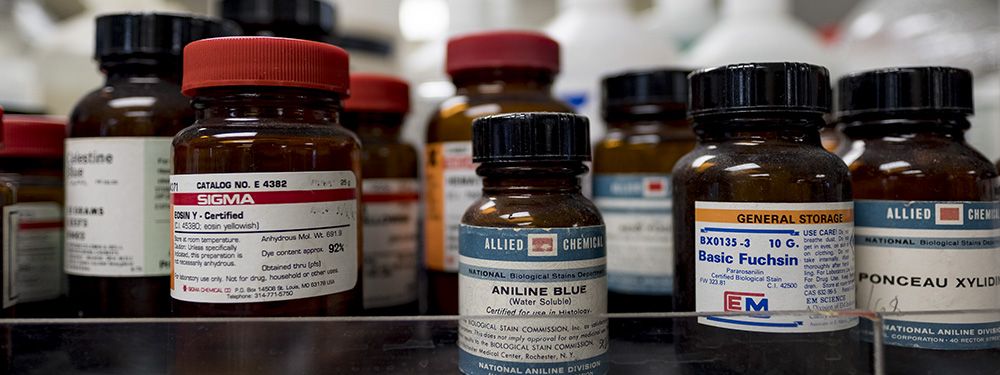
How a Radiobiologist Can Impact a Dozen Medical Fields
For the next 20 years, Miller established himself as an authority on the mechanics of bone resorption and rebuilding. His work with birds included the discovery that something magical was happening with bones during the egg-laying cycle. Further studies turned conventional wisdom about breastfeeding in humans on its head. Physicians in the 60s and 70s were more likely than in the past to advise women to bottle feed, not because of convenience per se, but because studies showed a marked decrease in bone growth and they were afraid that the breastfeeding baby was effectively “leaching” the bone from its mother, to ill effect.
Miller and others showed that bone resorption by osteoclasts releases all sorts of minerals (and other heavy metals) into the bloodstream. Bone, it seems, is a mineral store for the body, and we have a natural way to access those stored minerals. For breastfeeding mothers, those released minerals help to feed their babies. Importantly, Miller and his colleagues observed that after weaning, mothers go through a profound metabolic period of rebuilding bone – an effective safeguard and counter effect of the lactation cycle.
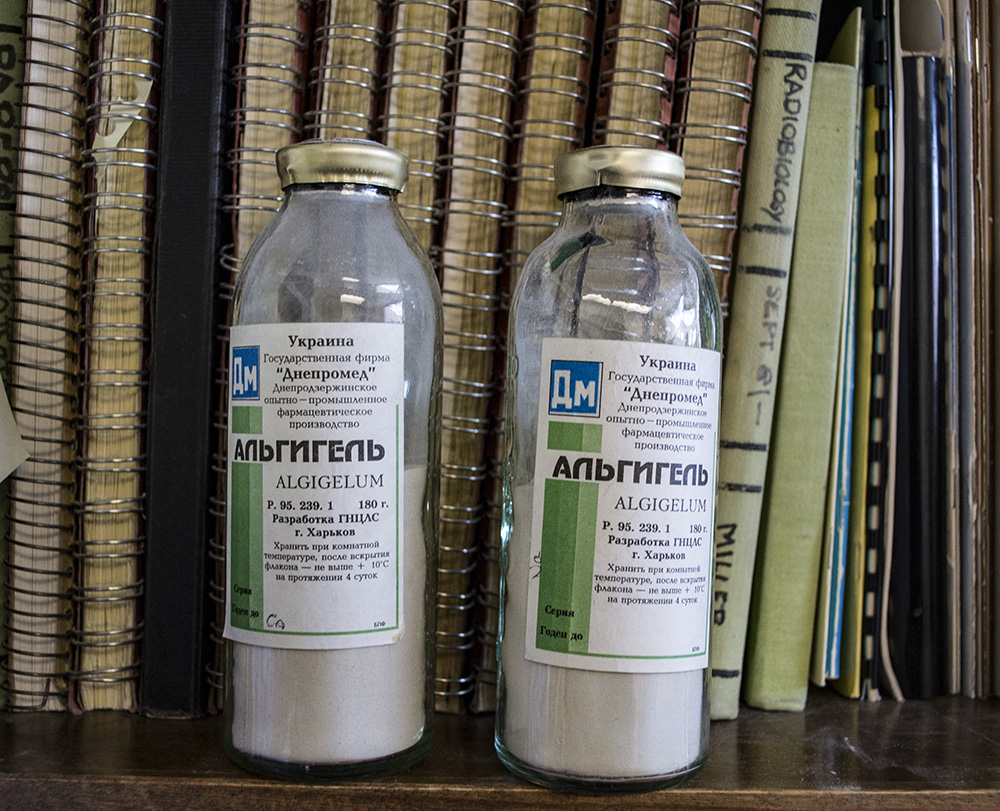 |
| Shelves in Scott Miller’s office with bottles of a Ukrainian algae-based powder thought to help leach metals from the human system. Photo: Michael Mozdy. |
“I always told the drug companies, if you could put lactation in a bottle or a pill, you’ve cured osteoporosis,” he declares. “We’re geared for that – evolution did it.”
Miller’s Harvard years yielded another surprisingly impactful study. His collaboration with a cancer researcher was the first study to take pictures of big sugar molecules on the surface of cancer cells. They postulated that these molecules were “masking” the molecules (i.e. antigens) on the surface of cancer cells that allow the body’s immune system to recognize the cancer. Forty years later, this discovery continues to drive important advances in cancer immunotherapy.
At the same time, Miller strengthened his expertise on the effects of different radioactive isotopes on biology. He conducted many studies determining how radioactive isotopes and their decay daughters are stored in the body – from bone to reproductive organs – and how this might impact not just the people exposed, but future generations.
By the late 1980s, the Soviet Union was on its way to breaking up, and the Russian government had begun to admit that there had been some significant nuclear accidents in the past. Russian scientists wanted to collaborate with the world’s best researchers to determine what type of health impact these accidents may have had. Along with a handful of others, Scott Miller’s name made it on the list of people who should be involved. Appointed as part of the Russia/U.S. Joint Coordinating Committee for Radiation Effects Research, by the mid-1990s Miller was on his way to the most secretive and polluted place on the planet.
The Picnic of Death
Ozersk is both a fulfillment of cold war paranoia and an anomaly of the Soviet mass production aesthetic. Not appearing on maps until the 1990s, not allowing citizens – Russian or otherwise – to enter, not allowing its own residents to talk about its existence: these are all expected, almost too-cliché-to-be-believed cold war attributes. Yet rather than brutalist architecture, you encounter baroque building ornamentation. Rather than the anti-intellectual culture promoted throughout the USSR, Ozersk employed a large proportion of highly educated scientists and gave them the space to be creative problem solvers. And instead of urban factories built to churn out one-size-fits all products for the masses, the singular Mayak production facility specialized in an elegant, one-of-a-kind agent of annihilation.
The contrast with the existing Ural mountain communities was not lost on Miller. “The forest around Ozersk is still dense,” he describes. “You see real Dr. Zhivago stuff – wood shacks and the like. And just down the road is the most radioactive piece of real estate on earth: Lake Karachay.”
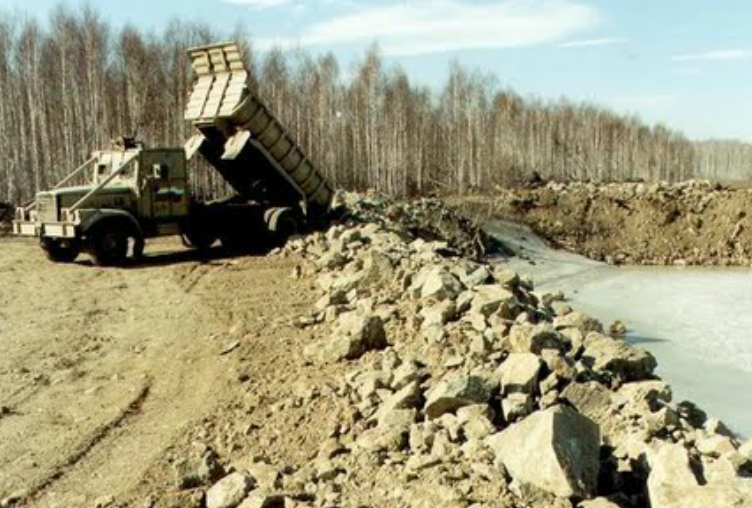 |
| Lead-lined dump truck filling in Lake Karachay to stabilize it. Photo: Wikimedia. |
For 20-some years, giant trucks with lead-lined cabins have been back-filling the lake, stabilizing it to prevent more airborne disasters. They just finished this work in 2015, but still your Geiger counter would be pegged to the top of the scale if you visited.
“It’s the kind of place,” Miller muses, “that if you went there for an afternoon picnic, you’d be dead. It’s that radioactive. Or you’d need a bone marrow transplant. I’ve been there twice, but it’s the type of place you drive by really fast.”
Miller considers himself fortunate to see secret nuclear sites that even Russians can’t gain access to. He is very aware of the unique role this place holds in the history of the world. “This is where Francis Gary Powers was shot down,” he explains, referring to the U.S.’s spy plane doing espionage work over Russia on May 1, 1960. “There’s a lot of political history there.”
Miller has had the uncanny luck to be present for several significant events in and around Ozersk. He and his team were the first (and perhaps last) group to be photographed standing atop the lid that blew off the tank in the Kyshtym Disaster (see picture below).
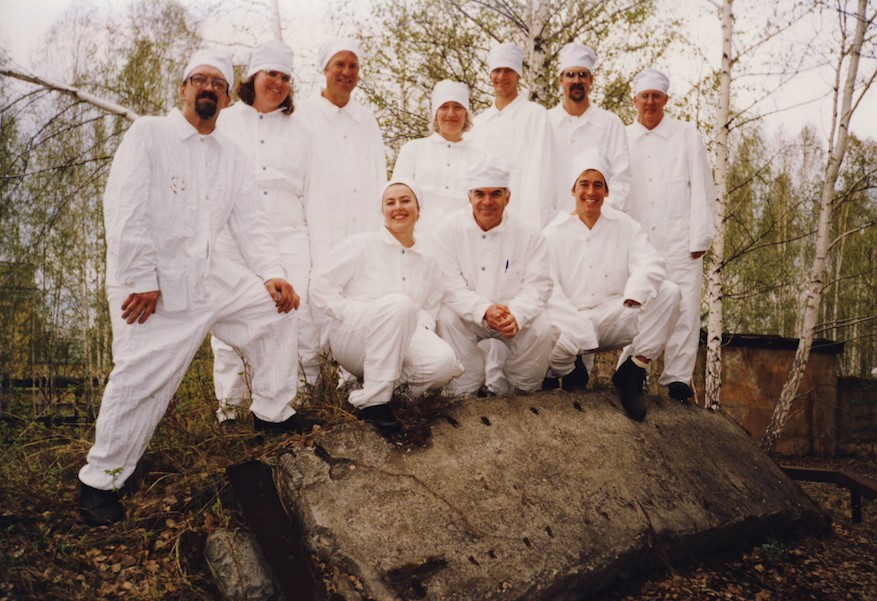 |
| U.S and Russian scientists standing on lid from Kyshtym Disaster (Miller on far right). Picture taken by Mayak security. |
He was visiting on February 15, 2013 when the Chelyabinsk meteor struck overhead with 30 times the energy of the atomic bomb at Hiroshima, sending a panicked Russian state into military lockdown since it was not on any astronomer’s radar. After a day of intense paranoia and scrutiny, home videos finally revealed the culprit of the shockwaves that sent thousands to hospitals, mostly from shattered and flying glass. Miller was also present recently in 2017 when elevated atmospheric levels of the element ruthenium – a byproduct of nuclear reactions – was recorded in the Urals and eventually floating over Europe. The source of the ruthenium is still under investigation, but Mayak is suspected.
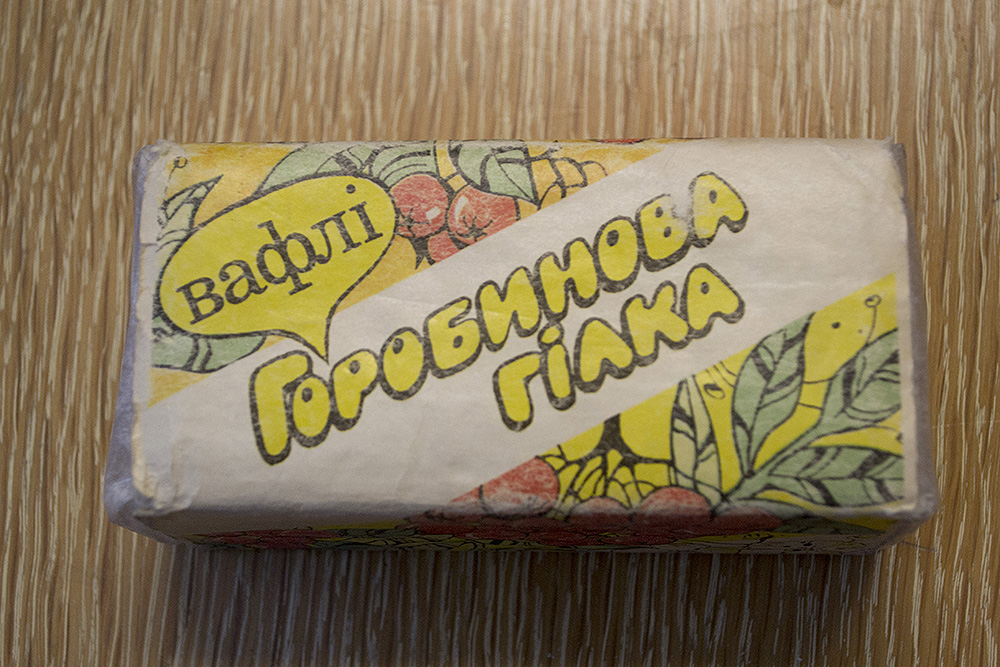 |
| A Chernobyl biscuit in Scott Miller’s office. Photo: Michael Mozdy. |
Interesting artifacts adorn his office and speak to the gulf that separated our societies during the cold war. One of them, a box of Chernobyl biscuits, sits on his bookshelf with the happy promise of scrubbing away toxic chemicals from your digestive tract and keeping you regular at the same time.
It’s clear that we experience ongoing turbulent international relations, yet despite the times he’s been held at the border without explanation, with nothing but a stern look and a confiscated passport to think about, Miller swears by the hospitality and collegiality of the Russians. “They’re the nicest, most hospitable people you’ll ever meet,” he declares, “once they realize you’re a scientist, not a spy.”
It’s clear that the Russian culture is quite guarded and careful. The 10-15 U.S. scientists who visit Ozersk a few times each year go through rigorous visa paperwork, protocols, and other restrictions imposed by the Russian government. Everyone is put under Russian escort throughout their stay, and they cannot visit Ozersk residents’ homes. Sometimes it feels like the cold war isn’t over.
New Science Built from the Bodies of Mayak Workers
 |
| Tissue samples of Mayak workers in Miller's lab. Photo: Ashlee Pinegar. |
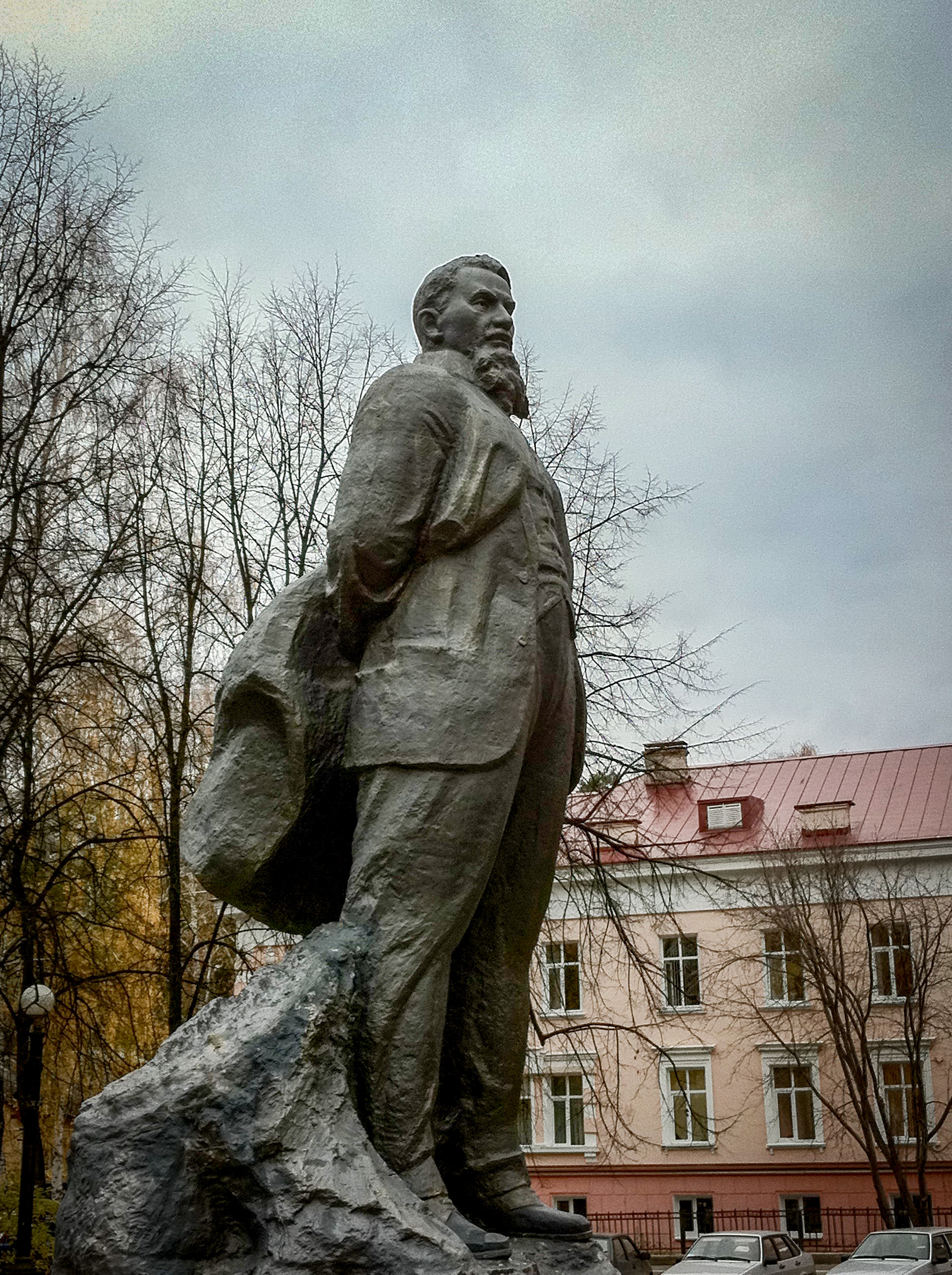 |
| Statue of the Soviet “father” of the nuclear bomb, Igor Kurchatov, in Ozersk. Photo: Scott Miller. |
Scientists from both countries agree that the effort is worth it. The Joint Coordinating Committee for Radiation Effects Research means to turn disaster into a deep source of knowledge. The Mayak workers are a large cohort of people who have sustained prolonged exposure to radiation in multiple forms, and both countries’ governments recognize the important and unique insights they provide for science.
Miller’s contribution is his deep knowledge of early animal studies of exposures to plutonium and other radioactive isotopes. Frankly speaking, he notes that there aren’t many of the Manhattan Project-generation scientists around anymore, and government programs aren’t built for long-term retention of scientific knowledge. “I’m kind-of the corporate memory of plutonium, americium, radium, thorium, polonium, strontium, cesium,” he claims. “I’m one of the last remaining biologists who understands where these metals go in the body – their distribution and the physiology of heavy metal storage.”
Barry Fountos, who has managed the Russian Health Studies Program for the Department of Energy for 16 years, seconds this assessment: “Scott has a tremendous amount of expertise in radiation biology, medicine, and how internal emitters move throughout the body.”
That’s why Miller is one of the principal investigators for the Mayak Worker Dosimetry Project. Thanks to the thorough records kept by the Russians at the Mayak facility, the joint U.S.-Russian team has access to the health and exposure records for 26,000 workers first employed there between 1948-
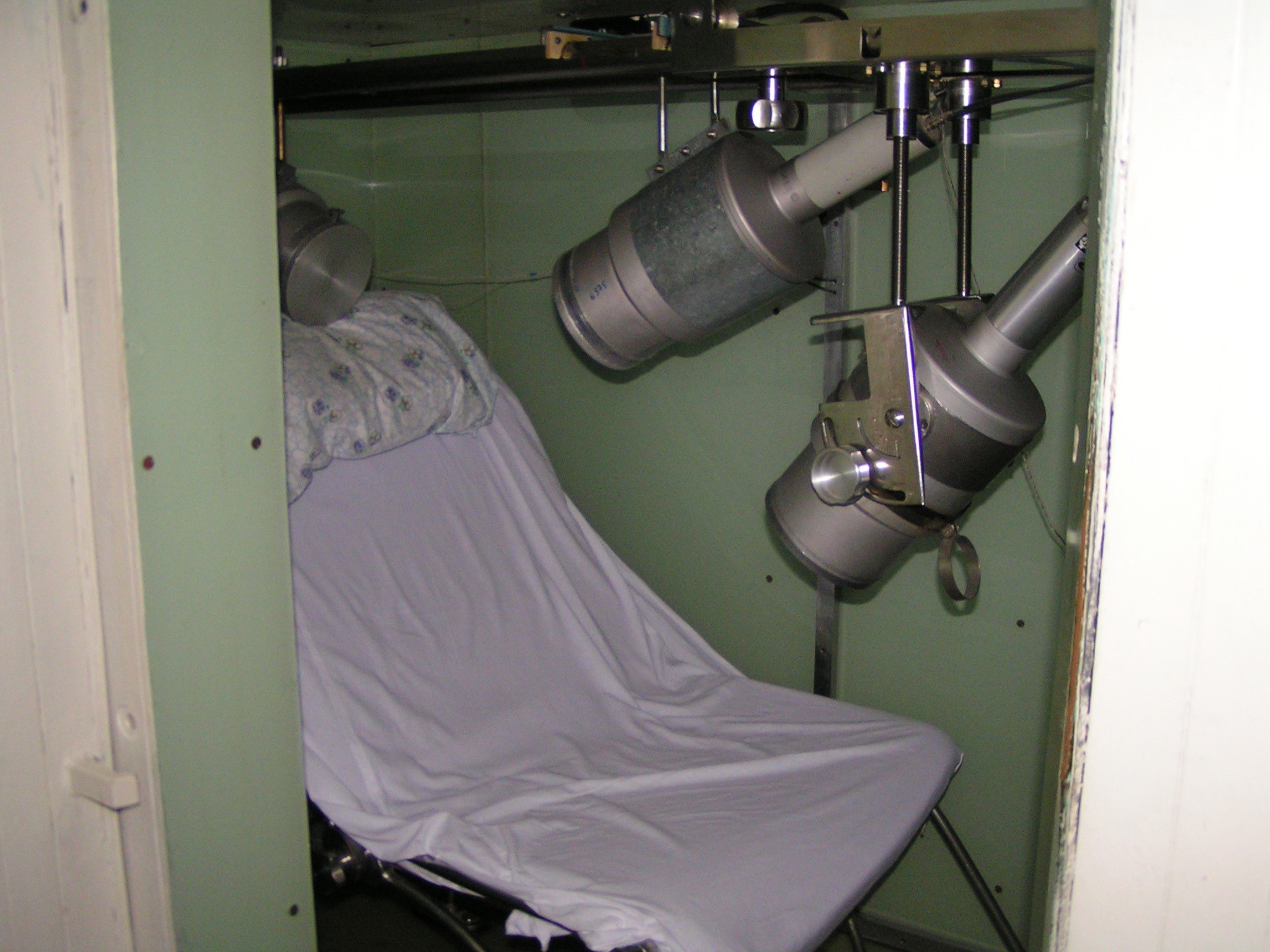 |
| Gamma radiation detectors in a steel-lined room (to reduce background radiation readings) in the Mayak facility. Photo: Scott Miller. |
1982. In the late 1940s, many workers were heavily exposed and after the Soviet government realized they were getting sick and dying, they started tracking exposures with dosimetry badges. They also built a room to record exposures that happened when someone was not wearing a badge – workers would spend an hour in this room while gamma radiation detectors recorded the radiation emanating from their body. The Mayak plant managers kept records of worker exposure data over decades.
Miller’s dosimetry project has produced “a computerized database of individual internal and external radiation doses and uncertainty about those doses for each member of the 26,000 Mayak worker cohort” (DOE website). This work has then been used by a team of epidemiologists to identify cancer risks as a result of dose. A third team has created a tissue, blood and DNA repository of thousands of exposed individuals that will be made available to researchers worldwide. All three projects are making actionable sense from a half century of disaster.
These teams published number of papers 2017, and are the first to demonstrate a statistically significant association between occupational exposure to plutonium and bone, lung, and liver cancer in humans. Miller was aware of this connection in animals, but the teams have now definitively shown this association in humans.
 |
| U.S. and Russian scientists in the forest outside of Ozersk. Scott Miller on far left, Barry Fountos on far right. |
Thanks to this work, other international agencies like the International Atomic Energy Association and the National Council for Radiation Protection and Measurements can examine and refine their radiation risk guidelines. Human health risk has been based on the Hiroshima atom bomb – an instantaneous blast and sudden exposure. The Mayak facility accidents and the intervening 50 years provide another set of benchmark data to help us understand radiation exposure in a different way. These agencies can use the data to see if their calculated risk of something like a CT scan or a trip in the stratosphere from New York to London is sufficient, under-protective, or overly protective.
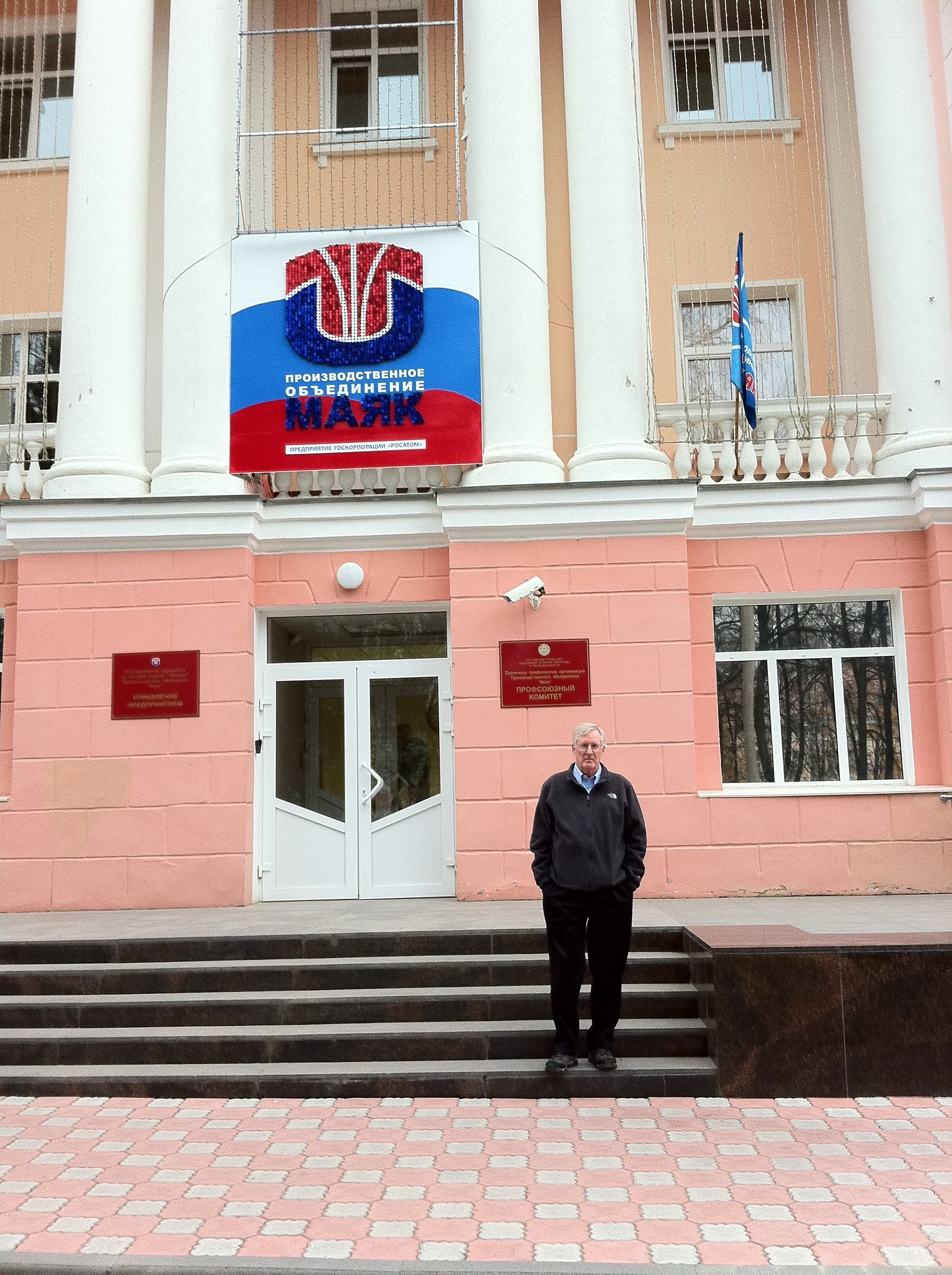 |
| Scott Miller outside of the Mayak nuclear production facility. |
It’s heartening to see something positive and cooperative emerge from of the race to obliterate a political enemy. Humans still face the dangers of nuclear proliferation, but Miller’s story shows us that trusted scientists can teach us how to understand their potential health effects.
“Scott is honest and honorable; I’ve really enjoyed working with him,” Fountos states. “He’s been a real asset to this particular project and to the program, and I hope that he’ll keep working on it.”
Miller’s record of scientific accomplishment is long here in Utah, yet we know that we can’t hold onto him forever. “He is one of the reasons I was excited to come to Utah,” declares the Chair of the Department of Radiology and Imaging Sciences, Satoshi Minoshima, MD, PhD. “I greatly enjoyed speaking with him when I interviewed and picking his brain about all things radioactive. Plus, I’ll never forget the truly local tour he gave me in his Jeep Wrangler.”
And this is truly Scott Miller’s legacy: meaningful science in a personable, unforgettable package. Very few people have seen the things he’s seen and contributed to our understanding of radiobiology the way he has. If you get a chance to meet him on campus, ask him to tell you a story or two from one of the most secretive and radioactive places on the planet.
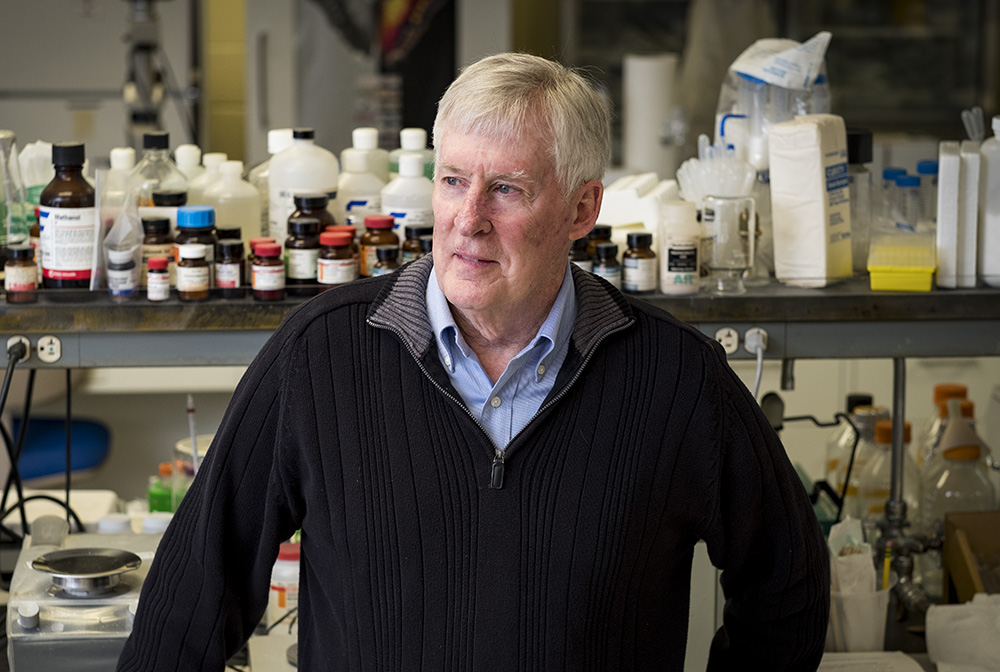 |
| Scott Miller, PhD, in his lab. Photo: Ashlee Pinegar. |